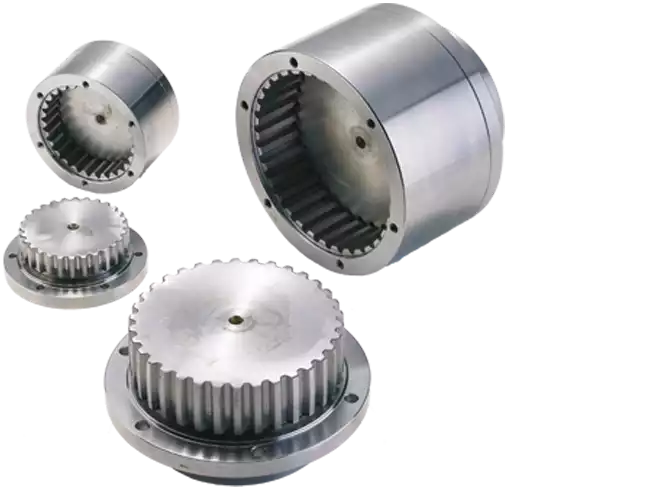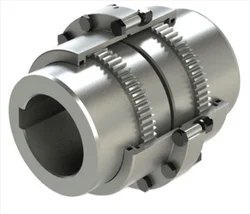Product Description
1.Small radial dimension and large bearing capacity are commonly used in shafting transmission under low speed and heavy load conditions.
2.It can compensate the relative offset of 2 axes in a certain angle and work long distance with the middle axle.
3.It is suitable for connecting horizontal 2 coaxial axes and driving shafting with a certain angle displaceme
Drum gear coupling, drum tooth is the external teeth made into a spherical, spherical center in the gear axis, side clearance than the general gear. The drum gear coupling can allow a larger angular displacement than the straight gear coupling. Moreover, the contact condition of the teeth is improved, so that the ability of transmitting torque is improved, and the service life of the coupling is prolonged. If the drum gear coupling to ensure safe and reliable work, good lubrication is essential, in exchange for slow wear. The high-speed drum-type gear coupling is mostly lubricated by lubricating oil, which needs to be filtered by high-precision oil filter, the filtrate is less than 10 microns, and the tooth surface requires continuous lubrication, otherwise the tooth surface temperature will increase and will accumulate moisture and dirt. Some high-speed drum-shaped gear couplings sometimes use the structure of oil-collecting groove hole, that is, the oil-collecting groove is processed in the outer gear shaft hole, and the oil hole which is communicated with the oil-collecting groove is drilled at the bottom of the outer gear groove, in order to make it fully lubricated, we rely on the drum-type tooth coupling high-speed operation of the centrifugal force, will be injected into the internal and external teeth mesh. Under the condition of angular displacement and stress concentration, the contact condition of the inner and outer teeth is improved by extrusion of the edge of the straight tooth, so that the friction and wear of the tooth surface are reduced and the noise is reduced. Under the same conditions, the load-carrying capacity of the drum-type gear coupling is increased by 15 -20% on average compared with the straight-type gear coupling in terms of the outer diameter of the inner gear sleeve and the maximum outer diameter of the coupling.
/* January 22, 2571 19:08:37 */!function(){function s(e,r){var a,o={};try{e&&e.split(“,”).forEach(function(e,t){e&&(a=e.match(/(.*?):(.*)$/))&&1

Industry Standards and Guidelines for Tooth Couplings
There are industry standards and guidelines that govern the design and use of tooth couplings. Some of these include:
- AGMA 9002-A94: This standard provides information on the selection and application of flexible couplings, including tooth couplings.
- ISO 14691: This international standard specifies methods for calculating the load capacity of tooth couplings.
- DIN 740: This German standard provides information on dimensions and requirements for tooth couplings.
- API 671: This American Petroleum Institute (API) standard specifies requirements for special purpose couplings, including tooth couplings, for use in the petroleum and natural gas industries.
These standards provide guidelines for the design, selection, installation, and maintenance of tooth couplings to ensure safe and reliable operation. Engineers and designers often refer to these standards to ensure that tooth couplings are used appropriately in various applications.

Specialized Maintenance Practices for Longevity of Tooth Couplings
To ensure the longevity of tooth couplings, specialized maintenance practices should be followed:
- Lubrication: Proper lubrication is crucial to reduce friction and wear between the teeth. Use lubricants recommended by the coupling manufacturer and ensure regular lubrication.
- Lubricant Quality: Use high-quality lubricants with suitable viscosity and additives for optimal performance and protection against corrosion.
- Lubrication Frequency: Follow the manufacturer’s recommendations for lubrication intervals. Factors such as operating conditions and environment can influence the frequency.
- Alignment: Maintain proper alignment of connected shafts to prevent excessive load and wear on the teeth. Misalignment can lead to premature failure.
- Inspection: Regularly inspect tooth couplings for signs of wear, damage, or misalignment. Early detection allows for timely repairs or replacements.
- Torque Monitoring: Monitor transmitted torque to ensure it remains within the coupling’s rated capacity. Excessive torque can lead to overloading and damage.
- Temperature: Monitor coupling temperature during operation. Elevated temperatures could indicate problems like inadequate lubrication or misalignment.
- Vibration Analysis: Use vibration analysis tools to detect abnormal vibrations that may indicate coupling issues or misalignment.
- Professional Inspection: Periodically have a professional inspect and assess the condition of the tooth coupling. They can identify potential issues that might go unnoticed.
- Replace Worn Parts: If wear or damage is detected, replace worn components promptly to prevent further deterioration.
- Manufacturer Guidelines: Adhere to the manufacturer’s maintenance recommendations and guidelines for the specific tooth coupling model.
Following these specialized maintenance practices can help ensure the reliable operation and extended lifespan of tooth couplings in machinery systems.

Factors for Selecting a Tooth Coupling
When choosing a tooth coupling for a specific application, consider the following factors:
- Load and Torque: Determine the maximum load and torque requirements of the application to ensure the coupling can handle the expected forces.
- Speed: Consider the rotational speed of the equipment as higher speeds may require specialized couplings with enhanced balance and accuracy.
- Alignment Tolerance: Evaluate the degree of misalignment the coupling can accommodate without affecting performance.
- Environment: Assess the operating environment, including temperature, humidity, and exposure to contaminants or corrosive substances.
- Size and Space: Choose a coupling size that fits within the available space and meets the connection requirements of the shafts.
- Backlash: Determine the acceptable level of backlash, as some applications may require minimal or zero backlash for precise motion.
- Shock and Vibration: Consider whether the application involves frequent shocks or vibrations and choose a coupling that can dampen these effects.
- Material: Select the appropriate coupling material based on factors like corrosion resistance, strength, and compatibility with the connected components.
- Maintenance: Evaluate the ease of maintenance, including access to lubrication points and the need for periodic inspection and replacement.
- Cost: Balance the performance requirements with the budget constraints of the project.
Considering these factors will help you choose the right tooth coupling for your specific application, ensuring optimal performance and reliability.


editor by CX 2024-03-12
by
Tags:
Leave a Reply